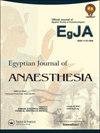Safety and efficacy of dexmedetomidine vs ketamine vs midazolam combined with propofol in gastrointestinal endoscopy for cancer patients: A randomized double-blinded trial
IF 0.6
Q3 ANESTHESIOLOGY
引用次数: 0
Abstract
ABSTRACT Background A wide range of drugs are used for sedation in gastrointestinal (GI) endoscopy procedures, including midazolam, dexmedetomidine, and ketamine. Therefore, this study aimed to compare the effects of these drugs in combination with propofol among cancer patients undergoing GI endoscopy. Methods This randomized, double-blinded study was carried out on 75 cancer patients who underwent GI endoscopy. Patients were categorized into three equal groups. Group D: received dexmedetomidine 0.5 µg/kg bolus infusion over 10 min. Group K: received ketamine 0.5 mg/kg. Group M: received midazolam 0.05 mg/kg. With these drugs, 0.5 mg/kg propofol was administered intravenously with incremental 20 mg till achievement of Ramsey sedation score (RSS) 3–4. After that, 0.5 mg/kg propofol boluses were offered for rescue sedation. Results The endoscopy duration was comparable in the three groups. Time of RSS 3–4 achievement and total propofol dose (P < 0.05) were significantly lower in group D and group K compared to group M. Time to eye-opening were significantly lower in groups D, and K compared to group M, with insignificant difference between group K and group D. Moreover, the heart rate (HR) and mean arterial pressure (MAP) of group K at 10 min, 15 min, 20 min, 25 min, and 30 min, and PACU were significantly greater than D and M groups (P < 0.05). Incidence of hypotension and bradycardia were comparable in the three groups. Conclusions In cancer patients who underwent GI endoscopy, dexmedetomidine-propofol and ketamine-propofol had better sedation efficacy [lower achievement time of RSS 3–4, total propofol dose, and eye-opening time] compared to midazolam-propofol group with superior sedative effect of ketamine-propofol than dexmedetomidine-propofol. While ketamine-propofol had more stable HR and MAP.癌症患者胃肠镜下右美托咪定、氯胺酮、咪达唑仑联合异丙酚的安全性和疗效:一项随机双盲试验
本文章由计算机程序翻译,如有差异,请以英文原文为准。
求助全文
约1分钟内获得全文
求助全文
来源期刊

Egyptian Journal of Anaesthesia
Medicine-Anesthesiology and Pain Medicine
CiteScore
0.90
自引率
0.00%
发文量
78
 求助内容:
求助内容: 应助结果提醒方式:
应助结果提醒方式:


